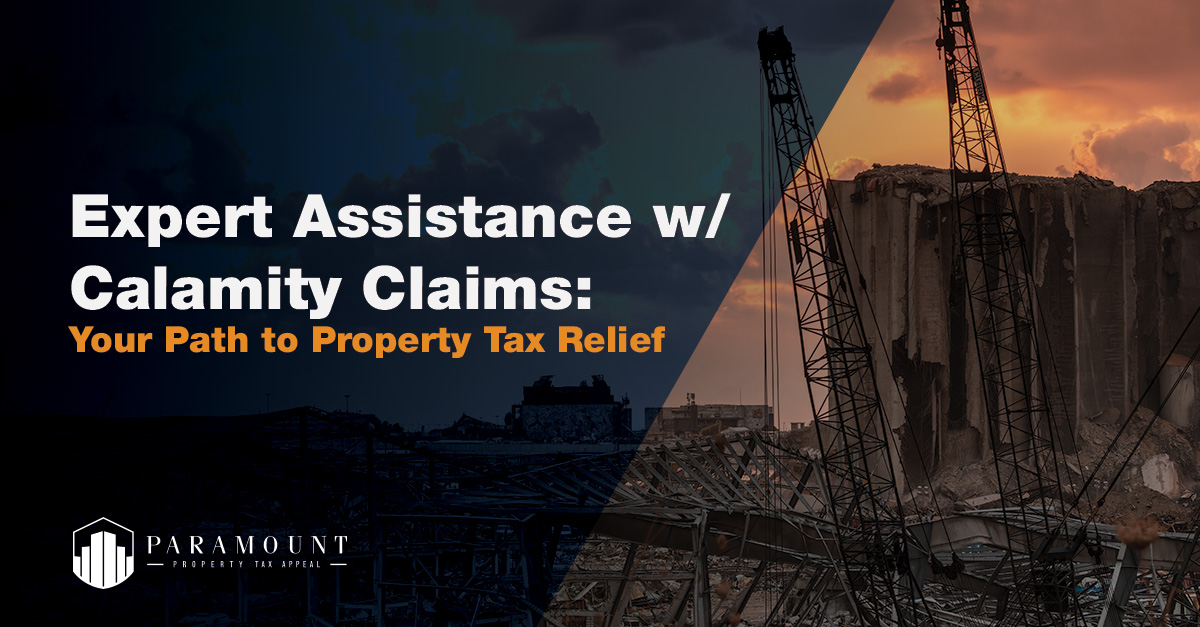In the Golden State, natural disasters such as wildfires, earthquakes, and floods are unfortunately all too common. While the immediate concerns during such events are safety and recovery, there's another aspect that property owners need to be aware of: the potential for property tax relief. The state of California recognizes the financial burden that can come with property damage, and as a result, has provisions in place to offer some relief in the form of Calamity Claims. This article delves into the intricacies of these claims, shedding light on how they relate to property tax and how homeowners can benefit from them.
What are Calamities in the Context of Property Tax?
When we hear the term "calamity," images of large-scale disasters might come to mind. However, in the context of property tax, the definition is more specific. A "disaster, misfortune, or calamity" is described as an event that is out of the ordinary, something that is unforeseeable, sudden, or unusual. This is in stark contrast to a gradual deterioration or a worsening condition over time, which wouldn't qualify for a Calamity Claim.
For instance, if a property was damaged due to a sudden wildfire, it would likely qualify for a claim. On the other hand, damage resulting from years of neglect or natural wear and tear would not be considered under this provision. Understanding this distinction is crucial for property owners, as it determines eligibility for potential tax relief.
Qualifications for Calamity Claims
Understanding the Eligibility Criteria
Before diving into the process of filing a Calamity Claim, it's essential to understand the qualifications that make a property eligible for such a claim. Not all damages qualify, and there are specific criteria that must be met.
The $10,000 Threshold
A key criterion for eligibility is the extent of the damage. For a property to qualify for a Calamity Claim, the physical damage must be valued at $10,000 or more. This ensures that the relief is provided to those who have experienced significant damage, warranting a potential reduction in property tax.
Exclusions to Consider
While the $10,000 threshold is a primary qualifier, there are certain exclusions. Damages caused by neglect or natural deterioration over time do not qualify for tax relief. For instance, if a property suffers damage due to poor maintenance or aging infrastructure, it wouldn't be eligible for a Calamity Claim.
Filing a Calamity Claim
Navigating the Filing Process
Once a property owner determines that they qualify for a Calamity Claim, the next step is to understand the filing process. This process is time-sensitive and requires attention to detail to ensure that all necessary documentation is provided.
Timeline for Filing
The property owner must file the completed application within twelve months of the calamity. However, if the Assessor’s office sends a notification within this 12-month period, the property owner will have an additional 60 days from the notice date to file the application. It's crucial to adhere to these timelines to benefit from the potential tax relief.
Importance of Accurate Documentation
When filing a Calamity Claim, accurate documentation of the damage is essential. This includes photographs, repair estimates, and any other relevant evidence that showcases the extent of the damage. Proper documentation not only supports the claim but also ensures that repairs are determined as non-assessable, which can have implications for future property tax assessments.
Property Tax Installment Deferral
Postponing Tax Payments After a Calamity
In certain situations, property owners may be eligible to defer their property tax payments. This provision is especially beneficial for those facing financial hardships following a disaster.
Conditions for Deferral
To be eligible for a property tax installment deferral, a few conditions must be met:
- The disaster must have been officially declared as a state of emergency or disaster area by the Governor.
- A Calamity Claim for reduction must have been filed.
- The deferral is available only for secured roll tax payments.
- The taxes must be paid directly by the owner. If taxes are paid through an impound account, the property does not qualify.
The Deferral Process
Upon meeting the conditions, property owners must file both a property tax installment deferral claim and a calamity claim before the next payment on the current tax year is due. For instance, if a disaster occurs in January, the deferral application must be submitted before April 10th to qualify.
Base Year Transfer to a Replacement Property
Transferring Tax Values After Major Damage
For properties that have suffered extensive damage, there's an option to transfer the base year value to a replacement property, potentially leading to significant tax savings.
Qualifying for a Base Year Transfer
To be eligible:
- The property must be located in Sacramento County.
- The damage must account for more than 50% of the property.
- The damage or destruction should be a result of a Governor-declared disaster.
Intra-County vs. Inter-County Transfers
There are two types of transfers based on the location of the original and replacement properties:
- Intra-County Transfer: Both the damaged property and the replacement property are located within the same county.
- Inter-County Transfer: The properties are located in different counties. However, Sacramento County does not have an ordinance for Inter-County Base Year Value Transfers.
Implications of Proposition 19
It's essential to note the changes brought about by Proposition 19, passed in November 2020. This law affects base year value transfers for specific scenarios, and property owners should be aware of its provisions when considering a transfer.
Calamity Reassessments and Appeals
Understanding Reassessments After a Calamity
After a property has been damaged and a Calamity Claim has been filed, the property may undergo a reassessment to determine its new value. This section delves into how these reassessments are calculated and what property owners can do if they disagree with the new assessment.
Calculating the Calamity Reduction
The reduction in property value due to a calamity is determined by assessing the extent of the damage. This involves comparing the property's value before the calamity to its value after the damage, taking into account repair costs and the potential decrease in market value.
Potential Tax Increases Post-Repair
Once the property is repaired or rebuilt, there's a possibility that property taxes may increase. However, this depends on the nature of the repairs and whether they're considered new construction or simply restorative measures.
Appeal Rights for Property Owners
If property owners disagree with the Assessor's calamity reassessment or if their claim is denied, they have the right to appeal. This process involves presenting evidence to support their claim and may require the expertise of property valuation professionals.
How Paramount Property Tax Appeal Can Assist You
Expertise in Calamity Claims and Appeals
Navigating the complexities of Calamity Claims can be daunting, especially when dealing with the aftermath of a disaster. That's where the expertise of Paramount Property Tax Appeal comes into play.
Comprehensive Assistance in Filing Applications
At Paramount Property Tax Appeal, we understand the intricacies of the Calamity Claims process. Our team is equipped to guide property owners through every step of the application process, ensuring that all documentation is accurate and submitted in a timely manner. With our assistance, property owners can be confident that their claim is in capable hands.
Winning Your Appeal
Should there be a need to appeal the Assessor's decision, our team is well-versed in building strong cases for our clients. We leverage our extensive knowledge of property tax regulations and our experience in handling numerous appeals to provide our clients with the best chance of a favorable outcome.
Personalized Service Tailored to Your Needs
Every property and calamity is unique, and so are the challenges that come with them. At Paramount Property Tax Appeal, we offer personalized services tailored to the specific needs of each client. Our commitment is to ensure that property owners receive the maximum tax relief they're entitled to.
Conclusion
In the face of natural disasters and unforeseen calamities, property owners in California have more than just immediate recovery to consider. The financial implications, especially concerning property taxes, can be significant. It's here that Calamity Claims come into play, offering a beacon of hope and potential relief for those affected.
Understanding the nuances of Calamity Claims, from eligibility criteria to the filing process and potential tax benefits, is paramount. Being well-informed not only ensures that property owners can navigate the aftermath of a disaster with clarity but also that they can make the most of the provisions available to them.
However, the process can be intricate, and the regulations ever-evolving. It's for this reason that property owners are strongly encouraged to reach out to the County Assessor's Office for assistance. Their expertise and guidance can prove invaluable, helping homeowners make informed decisions and ensuring that they receive the tax relief they're entitled to.
In conclusion, while calamities are unpredictable and often devastating, being proactive and knowledgeable about Calamity Claims can make the road to recovery a little smoother. It's a testament to the importance of staying informed and seeking assistance when needed.
Frequently Asked Questions
What is a Calamity in the context of property tax?
A calamity, in terms of property tax, refers to an unforeseeable, sudden, or unusual occurrence, as opposed to gradual deterioration over time. To qualify for a Calamity Claim, the cost to repair the physical damage must exceed $10,000.
Will a Calamity affect my Disabled Veterans' Exemption?
The impact of a calamity on the Disabled Veterans' Exemption depends on the extent of the damage and the specific provisions of the exemption. Property owners should consult with the Assessor's office for detailed information.
How is the calamity reduction calculated?
The calamity reduction is calculated by assessing the difference in property value before and after the calamity. This involves considering repair costs and any potential decrease in market value due to the damage.
If I disagree with the Assessor's calamity reassessment, do I have any appeal rights?
Yes, property owners have the right to appeal if they disagree with the Assessor's reassessment or if their claim is denied. The appeal process involves presenting evidence to support the claim and may require expert opinions.
.png)


.png?width=170&height=64&name=Logo%20320x120(2).png)





